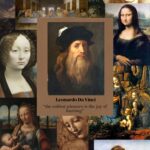Frida Kahlo: A Life of Pain, Passion, and Artistic Brilliance
Frida Kahlo, born on July 6, 1907, in Coyoacán, Mexico, is a name that resonates globally as a symbol of resilience, artistry, and empowerment. Her legacy is built not only on her groundbreaking art but also on her ability to turn personal struggles into powerful statements about identity, gender, and culture. Frida’s works continue to inspire millions worldwide, making her one of the most influential artists of the 20th century.
Early Life and Struggles
Frida Kahlo’s early life was marked by adversity, which would shape much of her artistic expression. She was born to a German father and a Mexican mother, and as a child, she faced the devastating impact of polio, which left her with a lifelong limp. However, the true turning point in her life came at the age of 18, when Frida was involved in a severe bus accident that left her with broken bones, internal injuries, and a fractured spine. This tragedy would result in numerous surgeries and a lifetime of chronic pain, but it also marked the beginning of her artistic journey.
While recovering in bed, Kahlo started to paint to pass the time, using a mirror placed above her so she could paint self-portraits. These early paintings reflected the isolation and emotional turmoil she faced, setting the stage for a unique artistic style that blended surrealism, symbolism, and Mexican folk traditions.
The Art of Frida Kahlo
Frida Kahlo is perhaps best known for her vivid self-portraits, which often incorporate symbolic imagery and vivid colors. Her paintings, deeply personal and often confronting, capture her physical and emotional pain. Some of her most famous works include:
- The Two Fridas (1939): This iconic double self-portrait depicts two versions of Kahlo, one in traditional Mexican dress and the other in a European-style gown, reflecting her dual cultural heritage and inner turmoil.
- Self-Portrait with Thorn Necklace and Hummingbird (1940): This powerful image shows Frida with a necklace made of thorns, a reference to the pain she experienced both physically and emotionally. The hummingbird represents hope, but it is surrounded by chaos.
- The Broken Column (1944): Depicting Frida’s broken body after her many surgeries, this self-portrait emphasizes her enduring pain. The column represents her fractured spine, while the nails piercing her skin symbolize the constant suffering she endured.
Daily Life and Impacts of Frida Kahlo
Kahlo’s daily life was marked by physical pain, but her artistic output was prolific, and her work became a way to process and express her suffering. She married renowned Mexican muralist Diego Rivera in 1929, though their relationship was tumultuous and marked by infidelities on both sides. Despite their personal struggles, they were both pivotal figures in the Mexican art scene, and Frida’s work was deeply influenced by Mexican culture, indigenous traditions, and political activism.
Frida was also known for her distinctive fashion sense, often wearing traditional Mexican clothing, such as brightly colored Tehuana dresses, and incorporating jewelry, flowers, and braids into her look. This personal style became iconic, and she became a symbol of empowerment, especially for women.
In addition to her artistic career, Frida was politically active, aligning herself with leftist causes and advocating for social justice. Her art often carried political messages, including her support for the Mexican Revolution and her sympathy for the working class and marginalized communities.
Facts About Frida Kahlo
- Self-Taught Artist: Despite receiving formal art education later in life, Kahlo was largely self-taught. Her work reflected her own experiences and emotions rather than conventional artistic standards of the time.
- Unique Art Style: Kahlo’s style is often associated with surrealism, though she rejected this label, stating that her work was not dreamlike but rather a depiction of her reality. Her paintings often blurred the line between reality and imagination.
- Unconventional Marriage: Frida’s marriage to Diego Rivera was unconventional, marked by love, infidelity, and shared artistic passion. They divorced in 1939 but later remarried in 1940.
- Physical Pain and Mental Struggles: Kahlo endured numerous health challenges throughout her life, including polio, a bus accident, multiple surgeries, and miscarriages. Her physical pain is often depicted in her art, creating a visceral connection with her audience.
- Political Activist: Frida Kahlo was deeply involved in politics, and her works often reflect her Marxist beliefs. She was an outspoken advocate for the rights of workers and the poor and supported the Cuban revolution.
- Legacy and Influence: Frida’s art was not widely recognized during her lifetime, but in the years following her death in 1954, she became a feminist icon and a symbol of strength and resilience. Her work has inspired generations of artists, particularly women, and continues to influence art, fashion, and culture today.
Significance of Frida Kahlo’s Work
Frida Kahlo’s work holds immense significance in the worlds of both art and culture. Her ability to blend personal pain with universal themes of identity, love, and struggle created a unique voice that continues to resonate with people worldwide.
- Feminist Icon: Frida is considered a feminist icon because her work challenged traditional gender norms and explored themes of female identity and self-expression. She unapologetically depicted her own body, embracing its imperfections and complexities. Her willingness to portray her physical pain and emotional struggles empowered women to embrace their own vulnerability.
- Cultural Legacy: Kahlo’s celebration of Mexican culture and indigenous heritage through her art has made her a cultural icon. She highlighted the beauty and significance of Mexican folk art, traditional clothing, and customs, making her an ambassador for her country’s rich cultural history.
- Emotional Rawness: Kahlo’s art is often deeply emotional, reflecting the inner turmoil of a woman grappling with physical suffering, mental anguish, and complex relationships. Her willingness to expose her pain through her art allowed others to connect with her on a deeply personal level.
FAQs About Frida Kahlo
1. What was Frida Kahlo known for? Frida Kahlo was known for her powerful self-portraits that conveyed themes of pain, identity, and Mexican culture. Her unique art style blended surrealism, symbolism, and folk traditions.
2. How did Frida Kahlo influence modern art? Frida Kahlo influenced modern art by challenging traditional artistic norms and creating deeply personal and emotionally raw works. She became a symbol of empowerment, particularly for women and marginalized communities.
3. What challenges did Frida Kahlo face in her life? Kahlo faced significant challenges, including physical pain from polio and a severe bus accident, as well as emotional struggles in her tumultuous relationship with Diego Rivera. Despite these challenges, she used art as a way to cope and express herself.
4. Was Frida Kahlo married? Yes, Frida Kahlo married Diego Rivera in 1929. Their marriage was marked by infidelities and personal struggles, but they remained an influential artistic duo.
5. How did Frida Kahlo’s art reflect her political beliefs? Kahlo’s art often incorporated political messages, including her support for the Mexican Revolution, Marxism, and social justice. She used her paintings to advocate for the rights of the working class and marginalized groups.
Conclusion: Frida Kahlo’s Enduring Impact
Frida Kahlo’s life and work left a lasting imprint on the art world and society. She transformed her personal suffering into a profound artistic expression, becoming an icon of strength, resilience, and individuality. Through her bold use of color, symbolism, and raw emotion, Kahlo’s art continues to inspire people across generations, making her a timeless figure in both the art world and beyond. Her legacy remains a beacon for those who face adversity, a reminder that beauty and strength can emerge from even the most painful experiences.










